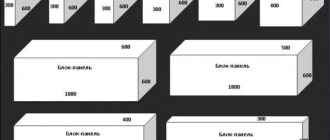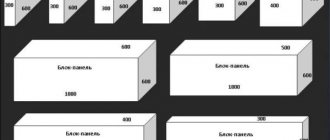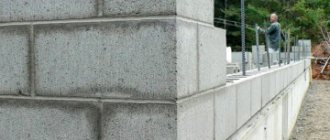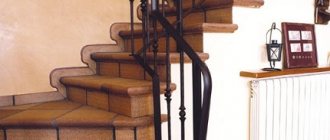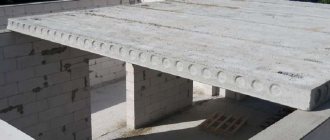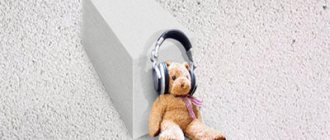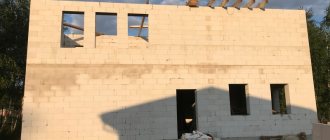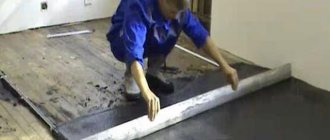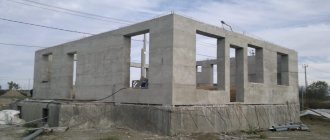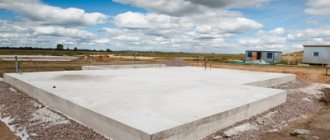Due to the porous structure of the blocks, aerated concrete walls have high thermal insulation properties. With a certain thickness, they can be erected even without additional insulation. But what the width of the masonry should be depends on many factors.
Choosing thickness for load-bearing walls
There are three main parameters that should be “linked” to each other in order to determine the optimal parameters:
- strength characteristics;
- resistance to heat loss;
- economic expediency.
That is, very powerful aerated concrete walls will be strong and warm, but unreasonably expensive. And cheaper half-block masonry can only withstand a small roof of a cold garage, but will not retain heat in a residential building. But if aerated concrete passes in terms of strength, the thickness of the structures can not be increased, but simply choose an affordable insulation material for finishing.
The optimal dimensions of the masonry need to be calculated several times, choosing the most suitable combination of all three parameters.
How thick should a wall made of aerated concrete be?
Aerated concrete is the most popular building material due to its thermal characteristics, low cost and high speed of wall construction.
One of the most important questions when building a house is the following: “how thick should a wall made of aerated concrete be?” After all, the issue of saving money on heating is more relevant than ever. To answer quickly, the thicker the wall, the stronger it is, and the better it retains heat. But not everything is so simple; economic feasibility is important.
In addition to its thickness, the thermal engineering of a wall is also influenced by the density of aerated concrete. The lower the density, the better the heat is retained. Most likely, you would just like to know how thick the aerated concrete wall should be, but in addition to all of the above, the choice of wall thickness is also influenced by the region in which you live, since the difference in temperatures between Siberia and Sochi is huge.
For central Russia, it is believed that the wall’s resistance to heat transfer (according to SNIP) should be about 3.2 W/m•C°. For colder regions of the country, this figure should be higher. Please note that for private construction, it is not necessary to comply with these standards.
Such thermal protection (3.2 m2 C°/W) is provided by the following options for single-layer aerated concrete walls.
- D300 – 300 mm.
- D400 – 400 mm.
- D500 – 500 mm.
It is worth noting that the overall thermal efficiency of a building is affected not only by the walls, but also by the insulation of the floor, roof, ceilings, reinforced belts, lintels, and windows. It follows from this that the heat loss of the building through the walls ranges from 30 to 40%. That is, making walls that are too thick is not rational. We need some balance between the costs of wall thickness and heating the house.
If we are talking about a permanent residence, then at current heating costs, the optimal thickness of a single-layer aerated concrete wall is: D400 - 400 mm, D500 - 500 mm.
For a country house that is visited quite rarely, a wall with a thickness of 250-300 mm made of D400 aerated concrete will be sufficient.
Advice and opinions from experts
When building a house, a person begins to compare characteristics between building materials.
There are several questions that need to be answered to select the right material:
Will the home be a permanent residence or for short stays? For permanent residence it is better to use ceramic blocks, and for temporary housing choose wood concrete blocks. What duration of construction do you expect? If you prefer to quickly build a house, you should give your choice to large foam blocks. Due to the large size of the material, the building will be erected many times faster. How important is durability and environmental safety? If this criterion is important for you, then your choice should be in favor of expanded clay concrete blocks. How much do you expect? The issue of saving is worth thinking about several times, because high-quality construction of a house requires investment. And as an inexpensive and high-quality material, it is worth considering foam blocks. What building materials are available in your region? Choose the material that is easy to find in your city
If you need to purchase additional material, it will be easy to find. Are you considering a possible sale? If you are thinking about a possible sale, you should pay attention to the use of cinder blocks. Houses with unusual cladding will quickly attract the attention of buyers.
By answering these questions, you will have a picture of your future home.
Do not forget that building a stone house requires constant heating. The stone should not be left to freeze in the cold season.
Thickness of aerated concrete with insulation
Now as for multi-layer walls, that is, insulated. Stone wool, polystyrene foam and low-density aerated concrete are usually used as insulation materials.
By using insulation, the thickness of load-bearing walls can be reduced, achieving a certain value of thermal resistance. That is, the cost of aerated concrete will decrease, but the cost of insulation will increase. Thus, you need to look for a balance between the thickness of aerated concrete and the cost of materials for insulation.
To make it easier for you to decide on the thickness of aerated concrete and insulation, we have found tables on the thermal parameters of wall materials.
Heat transfer resistance (R0) of aerated concrete depending on the thickness of the masonry.
The higher the value, the better.
Economic feasibility of insulation
Now that we have determined the thermal insulation characteristics of the building, we should evaluate the return on possible costs. To do this, you should estimate the amount of upcoming insulation costs, and compare the result with the cost of heating.
According to first estimates, the surface area of the walls of a 7 x 7 house will be 100 square meters. meters. The estimated cost of thermal insulation of such a cottage will be 100 – 150 thousand rubles. The service life of mineral wool exceeds 25 years.
A basic calculation shows that the game is worth the candle. The house should be insulated, especially since any subsequent increase in energy prices will result in savings for you: you have already invested the money.
You can ask your question to our author:
Table (thermal conductivity coefficient of aerated concrete)
The lower the value, the better.
For greater clarity, let's make calculations.
For example, you want to build a house in the Moscow region. The required value for thermal resistance in Moscow is R=3.28 . Your house is made of autoclaved aerated concrete D500 with a thickness of 300 mm, and you need to decide on the thickness of the insulation.
The thickness of the aerated concrete wall (0.3 m) is divided by the thermal conductivity coefficient of aerated concrete D500 (0.14).
Thermal resistance of the wall R = 0.3/0.14 = 2.14 m2 °C/W.
Next, we subtract the resulting thermal resistance R (2.14) from the required value R(3.28).
This means the thermal resistance of the insulation should be 1.14 m2 °C/W.
Thermal conductivity coefficient of mineral wool = 0.04.
Multiply 1.14 by 0.04 = 0.0456 meters, that is, 45 mm.
That is, the required insulation thickness was 50 mm.
Thus, you can calculate the required insulation for any wall.
Comfortable temperature in the living rooms of our house
This indicator is tied to the temperature inside the building/apartment. In order for the calculated value of the thermal resistance of the walls to be objective, the optimal level of air temperature in the room must be determined.
Let's turn to the reference book on climatology GOST 30494-2011:
- The temperature range in the room at which a person feels comfortable is 17o-22o C.
Now we need to calculate the volume of heat that we must provide for normal life during the heating season. This value is measured in degree days. We define it like this:
We find the difference between the calculated comfortable temperature inside the room and the average temperature outside the window. This data is in table No. of the GOST reference book.
- In the table we look for a line with indicators for Moscow. Degree-second values are divided into columns for several temperatures. We only need a few. According to the climatology reference book, the permissible temperature limits are 17o - 22o. Select the required numbers from the corresponding columns:
- 18o – 4100;
- 20o – 4500;
- 22o – 4900.
We will carry out the calculation for a temperature of 20o C: GSOP for this value corresponds to 4500.
- In Table 4 we find the standard values of GSOP and R. They are equal to 4000 and 2.8 W / (m x oC2), respectively.
- Let's interpolate the value of the limiting heat transfer coefficient for the Moscow region:
- We take the data from Table 4 as a basis. Find the degree-seconds. The value we need is close to the 4000 indicated there. It corresponds to a coefficient of 2.8 W / (m x oC2). We find the excess coefficient:
4500 : 4000 = 1,125;
We recalculate the value of the thermal resistance coefficient:
2.8 x 1.125 = 3.15 W / (m x oC2);
Thus, we obtained the minimum wall resistance that a building must have in order to ensure comfortable living when a given amount of thermal energy is supplied.
The found standard value of the maximum minimum resistance for the Moscow region is 3.15 W / (m x oC2).
- Let's compare the calculated ability of our walls to retain heat with the required values
The insulation capacity of aerated concrete walls plastered on both sides is 2.79 W / (m x oC2). The calculated coefficient for the capital region is 3.15.
Conclusion: The heat-saving capacity of our housing does not reach the minimum standard. The Moscow region needs thicker walls.
Vitaly Kudryashov
Builder Author of the portal full-houses.ru
Ask a Question
Comfortable temperatures range from 19° to 20° C. However, owners of private houses often prefer relative coolness. And there are more opportunities to limit the upper level of heating of rooms in an individual house.
It should be noted that we use the requirements of the standard as a reference.
Block classification
Aerated concrete is a porous building material. It contains: cement, lime, aluminum powder, quartz sand and water. During the process of mixing and making blocks, a reaction occurs that produces hydrogen. The mixture is then subjected to vibration and hardens. Blocks of the required size are cut out of a large solidified mass. Their width can be from 7.5 to 50 centimeters. Length from 60 to 62.5 centimeters. Height from 20 to 25 cm.
When choosing sizes, it is necessary to take into account the purpose and size of the building, seasonality of use, service life and monetary costs. And only after this should you choose the thickness of the blocks, since this will determine the heat, sound insulation and much more.
Main types
The requirements for blocks in terms of strength and thermal insulation may be different and they depend on what kind of room will be built. If this is a non-residential building, then it is necessary that the walls are simply strong, but when constructing a residential building, it is important to take everything into account. There are several types of aerated concrete block:
- Thermal insulation . The density of such a block is 300-500 kg/m3. This type is suitable for the construction of self-supporting walls or it can be used as additional insulation.
- Structural . Density - from 1000 to 1200 kg/m3. It is light in weight, so it is used for the construction of large objects.
- Structural and thermal insulation . Density - from 500 to 900 kg/m3. This type is suitable for the construction of low buildings. It is considered a warm and durable material.
This building material, when used correctly, has a lot of advantages. The main thing is to take into account its main characteristics and coordinate it with the conditions and location of construction.
Material Density
The density of a block is determined by its weight and is designated by the Latin letter D, and the numbers indicate the width. For example, grade D 500 represents a block with a width of 50 cm. There are several grades of density (D):
Related article: Is it necessary to prime the walls after finishing putty?
- D 50, D 100, D 250 - have a minimum density, so they are best used for laying interior walls without loads.
- D 300, D 400 - used for the construction of load-bearing walls. This brand can be recommended for the construction of two-story houses.
- D 500, D 600 - are highly resistant to frost, their price is much higher than previous brands. Suitable for laying facade walls of a three-story house.
- Grades from D 600 and above are recommended for the construction of durable special structures.
Density must be taken into account first of all when calculating the load on the foundation of a building at the initial stage of work.
Marking by density type
This indicator determines the area of use of aerated concrete. Measured in kg per m3, the numerical indicator indicates the grade of concrete that was used in the manufacture of the aerated block. Accordingly, this answers the question of which aerated concrete is better to build a house from.
The lower the numerical designation of the brand, the lower the density and specific gravity of the building material. But the thermal insulation value of “smaller” blocks is higher than that of a product with a “larger” label.
Blocks of various brands are conventionally divided into:
- Structural. They are also the most durable and have a high specific gravity. Used in the construction of load-bearing walls. The product is often used in buildings up to 3 floors. These brands also include D blocks. Such blocks are best chosen when building a cottage or country house
- Structural and thermal insulation. These include brand D. Recommended for the construction of load-bearing structures, as well as internal partitions of the building
- Thermal insulation. These are the least durable materials. We are talking about the marking of aerated concrete blocks D200 - D. They are used as a heat insulator. They are also suitable for creating partitions inside a building.
The marking is a guide for the user from the manufacturer. Thanks to this indicator, it is easier for a builder to understand which brand of aerated concrete is better to choose. The strength of the house, and even the safety of the people in it, depends on the correctness of this choice.
Regulatory Requirements
In order to understand what thickness a wall made of aerated concrete should be, first of all you should familiarize yourself with the regulatory requirements for the use of aerated concrete blocks, which are regulated by the document STO 501−52−01−2007. This document contains all the necessary recommendations:
- Height of buildings. For a load-bearing wall, the maximum height is 20 meters. And for self-supporting ones - no more than 30 meters.
- The strength of the blocks must be at least B3.5 during the construction of a house with five floors, and a mortar of class M100 is used. For a three-story building - B2.5 with M75 mortar. And for a two-story building, the strength class of the block should be B2 using M50 mortar.
Based on these requirements, the main indicators of the designed structure are calculated.
Optimal wall thickness
You can build anything from aerated concrete, but when constructing residential buildings, important recommendations must be taken into account. When constructing low-rise buildings, the main purpose of which is living in the summer, you must adhere to certain rules:
- When building a one-story house in warm areas, the thickness of aerated concrete blocks should be at least 20 cm.
- For high-rise buildings, a gas silicate block 30 cm thick is required.
- For the base and basements from 30 to 40 cm, but for these purposes it is better to choose another material, since aerated concrete is afraid of moisture.
- Interior partitions should be at least 15 cm, and between apartments - from 20 to 30 cm.
The thickness of the aerated block for a house that will be built for permanent residence depends on the climatic conditions of the area. With the correct calculation, you don’t even need to use insulation. And to make it easier, experts have already calculated the heat transfer resistance for some regions: Astrakhan region - 2.1, Altai - 3.5, Volgograd region - 2.8, Moscow region - 3.29, Chukotka - 4.9, St. Petersburg - 3.29, Krasnodar Territory - 3.5.
These indicators are calculated for the construction of buildings without the use of insulation. But if you still plan to make walls with insulating material, then calculating the thickness of aerated concrete blocks for external walls is even easier. In this case, only the quality and density of the material can be taken into account.
To what extent should a house made of 300 mm foam concrete be insulated?
To determine the thickness of the required insulating layer, we will use the same formulas that we used to calculate the energy efficiency of the walls. However, we will slightly change the calculation method.
- Let us find for ours the difference between the calculated heat transfer resistance coefficient and the standard one:
3.15 – 2.79 = 0.36 (W / (m x oC2);
- In Appendix T we find the corresponding calculated thermal conductivity coefficients λ for different types of insulating materials. Choose:
- λ for foam plastic – 0.049;
- λ for polystyrene – 0.051;
- λ for mineral wool – 0.56.
- For each value we calculate the value δ - the required thickness of the material:
0.36 x 0.049 = 0.01764 m;
0.36 x 0.051 = 0.01836 m;
0.36 x 0.075= 0.027 m.
Thus, for insulating our walls, foamed polymers with a cross-section of about 2 cm or cotton wool of 3 cm are suitable. But if foam plastics of this thickness are available on the market, then the minimum thickness of the wool is 50 mm.
Two parameters influencing the choice of insulation
When choosing facing and insulating materials, two criteria should be taken into account:
- The ability of the product to conserve heat. This is the reciprocal of the thermal conductivity coefficient.
- The ability of the product to conduct steam. Characterized by vapor permeability coefficient.
For aerated concrete, both parameters are extremely important. We found out how thermal insulation parameters affect operation. It remains to understand the ability of the mineral to accumulate and release moisture.
This porous material has good sorption. He likes it dry. After all, even under normal operating conditions, a wall can accumulate up to 30% moisture.
It is known that indoor air contains 50–70% water. Research has shown that porous blocks absorb this liquid well. However, the walls do not get wet. Thanks to its good vapor permeability, the mineral releases all the moisture accumulated in winter into the atmosphere in summer. Under normal operating conditions, single-layer concrete contains only 6% water, and this level is defined as standard.
It is absolutely clear that after insulation, aerated concrete must maintain vapor permeability, otherwise all the accumulated moisture will remain in the thickness of the walls.
The thickness of aerated concrete walls - the best options
Aerated concrete block products differ from conventional concrete in their low thermal conductivity. This quality is achieved by the presence of aluminum powder in the feedstock. Hydrogen bubbles spread throughout the hardening mass, which allows aerated concrete to transfer less heat than concrete. But this advantage is fraught with a decrease in strength, which is relevant when comparing blocks with concrete analogues. Based on this, the thickness of aerated concrete walls is determined taking into account the required level of thermal insulation and structural strength. And here there is another important feature - full compliance with the existing budget.
"AltaiStroyMash" - equipment for the production of aerated concrete
Due to the great popularity of aerated concrete blocks, the production of this essential building material is becoming a very profitable business. offers ready-made production solutions for launching your business for the production of non-autoclaved aerated blocks. Russia, Kazakhstan, Uzbekistan is not a complete list of countries where the company’s equipment has been operating reliably for a long time. And due to the fact that demand far exceeds supply, the production of aerated concrete will continue to generate income for a long time.
The payback period for a business during the construction season is 3-4 months. On the company's website you can familiarize yourself in detail with a wide range of production lines. An excellent option for investing in great prospects!
Load-bearing wall thickness
The construction of any object is preceded by strength calculations. It is not always possible to perform such actions on your own; for this reason, it is allowed to use parameters that determine strength.
The thickness of the load-bearing wall is determined taking into account these data.
Another important factor is the purpose of the facility being built. If the house is low-rise and is intended to be used during the summer season, it is recommended to comply with a number of simple requirements:
- when constructing a one-story building in an area with a warm climate, a garage and other outbuildings, aerated concrete 250 mm thick is used;
- for two- or three-story buildings this parameter increases to 300 mm;
- when constructing basements or ground floors, the recommended wall thickness is from 30 to 40 cm. But remember that aerated concrete is afraid of abundant moisture, so it is necessary to use other materials.
If the construction of a facility intended for year-round living is meant, the strength indicator is not enough. In this case, the thermal conductivity of the material is taken into account. Using calculations, the minimum thickness of an aerated concrete wall is determined, or the same parameters remain as for summer houses, but the external walls are additionally insulated. In this case, the calculation is carried out according to the available money - a more profitable option is determined. Either the thickness of the load-bearing aerated concrete wall is increased, or insulation is used.
When determining the cost of insulation material, do not forget about fasteners and the cost of specialist services.
Advantages of single-layer external walls
Especially in areas with mild winters, it is cheaper and easier to build a private house with single-layer external walls made of aerated concrete - gas silicate without additional insulation. These modern building materials make it possible to build a fairly heat-saving single-layer wall of reasonable thickness and the required strength.
Compared to two- and three-layer walls, a single-layer exterior wall design has the following advantages:
- The total cost of building a house with single-layer external aerated concrete - gas silicate walls with a masonry thickness of up to 40 cm, at least, does not exceed the cost of building a two-layer, and less than a three-layer wall. Such walls make it possible to ensure high consumer properties of housing
, and at the same time reduce the cost of construction in areas with less severe winters. - The homogeneous design of a single-layer stone wall provides greater durability, environmental friendliness, and better resistance to mechanical, fire and climatic influences.
In the thickness of a single-layer wall there are no less durable and non-impact-resistant insulation and polymer films, there are no ventilated gaps, there is no risk of moisture accumulation at the boundary of the layers, and protection from rodents is not required. - According to STO 00044807-001-06, buildings up to 5 floors with external walls made of autoclaved aerated concrete blocks have a predicted durability of 100 years, and the service life until the first major repair is 55 years. For comparison, the duration of effective operation of buildings insulated with mineral wool or polystyrene boards before the first major repair is 25-35 years. During this period, a complete replacement of the insulation is required.
- A single-layer wall is least susceptible to accidental or deliberate damage.
- A single-layer wall is the key to the absence of hidden defects:
it is impossible to place insulation poorly in it, since the insulation is the masonry material itself; it is impossible to perform a bad vapor barrier in it, since it does not need a vapor barrier; the entire wall is in front of your eyes and you don’t have to worry about the state of the foam or mineral wool hidden in its depths - nothing is hidden in the wall. - Finishing the facade of a single-layer wall is cheaper and more durable than finishing walls using insulation.
- Laying a single-layer wall is faster
, as it is made from large-format blocks and does not require additional work on wall insulation. - For laying single-layer walls, as a rule, blocks with a tongue-and-groove side surface are used, which makes it possible not to fill the vertical joints of the masonry with mortar. As a result, the consumption of masonry mortar is reduced by 30-40%
.
Thickness of partition walls
This parameter is selected taking into account certain factors, the load-bearing capacity is calculated and the height of the partition is taken into account.
When choosing blocks for such walls, you should pay close attention to the height value:
- if it does not exceed the three-meter mark, then the optimal wall thickness is 10 cm;
- when the height increases to five meters, it is recommended to use blocks whose thickness is 20 cm.
If there is a need to obtain accurate information without performing calculations, you can use standard values, which take into account connections with the upper floors and the lengths of the walls being erected. Particular attention is paid to the following tips:
- when determining the operational load on the internal wall, it becomes possible to select optimal materials;
- for load-bearing partitions, it is recommended to use D 500 or D 600 blocks, the length of which reaches 62.5 cm, the width varies from 7.5 to 20 cm;
- the installation of conventional partitions involves the use of blocks with a density index of D 350 - 400, which makes it possible to improve standard sound insulation parameters;
- The sound insulation indicator fully depends on the thickness of the block and its density. The higher it is, the better soundproofing properties the material has.
Related article: Insulation for exterior house walls under plaster
If the length of the partition is eight meters or more, and its height is four meters or more, then in order to increase the strength of the entire structure, the frame base is reinforced with a reinforced concrete reinforcing belt. In addition, the required strength of the partition can be achieved by using the adhesive composition used for laying.
Payment procedure
Aerated concrete blocks have precise geometry. Due to this, they can be laid on a thin layer of the binder mixture. When determining glue consumption, you need to adhere to a special algorithm.
The standard consumption of aerated concrete adhesive per 1 m 3 varies from 15 to 30 kg of dry mass. With a layer thickness of 1 mm, about 25 kg of mixture per cubic meter is required. This is one bag of composition.
Similar proportions are typical for blocks with a flat surface, without visible deformations. It is recommended to take one bag of glue in reserve. For example, if 20 cubic meters of aerated concrete blocks were purchased, then 21 bags of adhesive will be required to lay them.
It is not always possible to purchase a batch of ideal blocks. Therefore, in practice, glue consumption can be 1.5 bags per 1 m 3. All these figures are approximate and depend on various factors.
To accurately calculate glue consumption, you should use the following formula: ((L+H)/(L×H))×d×1.4
P is the glue consumption in kilograms per cubic meter;
L, H – length and height of the aerated concrete block, respectively (in meters);
1.4 – the consumption value of the dry adhesive mixture, provided that the layer thickness is 1 mm.
Today there are many specialized resources where you can determine glue consumption using an online calculator. This tool takes into account various factors that can affect the volume of block bonding compound.
Wall thickness for different regions
The optimal option for designing an object is complete calculations of strength and thermal conductivity, but not every person is capable of such a task. And there is no desire to pay money for the services provided. In such cases, you should focus on the approximate strength and thickness of aerated concrete blocks for external walls.
Compared to other materials, aerated concrete has a significantly smaller thickness with the same energy efficiency.
Such advice is considered to be recommendations of an average nature, compiled mainly on the basis of statistical data on the use of aerated concrete material in the construction industry and recommendations of manufacturers.
If construction is to be done in a region with warm climatic conditions, then the thickness of the walls should be from 20 cm. But the value is advisory, and many developers opt for 30 cm.
What thickness should be the walls of objects being built in other regions of Russia? Here everything depends on the average daily temperature. For example, for Siberia, the thickness of an aerated concrete wall should be greater than in the southern regions.
Marking: material characteristics
Aerated concrete blocks are divided into types in relation to their purpose, namely:
The walls of a building are usually built from a material belonging to the structural type.
The specific gravity of aerated concrete depends on the filler. In this regard, aerated concrete is:
The material containing expanded clay is of the light type.
A significant disadvantage of the material is the low coefficient of strength and bending to tensile parameters. A volumetric object requires mandatory reinforcement.
GOST requirements
Construction work using cellular concrete material is regulated by special requirements. The main recommendations for using blocks are as follows:
- regulatory documents require that the maximum height of the wall be determined by calculation;
- building heights are limited. It is allowed to build five-story buildings with a height of two dozen meters from blocks that have undergone autoclave processing. Self-supporting walls in nine-story buildings should not exceed thirty meters. Foam block material is used in the construction of a three-story building, the maximum height of which does not exceed ten meters;
- The standard defines strength indicators taking into account the number of floors. Block B 3.5 is used for the construction of a five-story building, and for three- and two-story buildings, B 2.5 and B 2 are used, respectively;
- For self-supporting walls, block material B 2 - 2.5 is used.
Advantages of working with our company
We do it on time or for free. Construction is divided into stages with a specified completion date. "Full construction". All work is done by one company. Possibility of accepting payments in installments or on credit. No hidden fees. The price is final at the contract stage. Quality control is carried out at every stage of house construction by our competent services. Thanks to high-quality construction work. We have more than 300 successfully completed projects. Delivery of materials within 200 km from the Ring Road for freeGet a free estimateBuilder reviews
How thick should the walls be?
Aerated concrete is considered an effective material for heat preservation, and is explained by its cellular structure.
To accurately determine what thickness of aerated block to choose, you must follow the following useful recommendations:
- In construction work, a special masonry mortar is used, which is applied to the block surface in a thin layer. This especially applies to people who constantly work with cement mortars. Thick seams will begin to let in cold, which will negatively affect the thermal insulation characteristics of the block;
- if construction is carried out in areas with cold climatic conditions, then the aerated concrete wall is insulated on both sides;
- strength calculations must take into account the additional mass created by thermal insulation materials.
In addition to official calculations, builders determine additional factors that help determine the thickness:
- Duration of use at home. If the option is a country house, then the thickness of the walls can be twenty centimeters. They will be able to withstand the weight of the roofing and protect from spring and autumn coolness. If you plan to stay all year, the thickness indicator doubles.
- Load-bearing walls should be ten to fifteen centimeters greater than the thickness of the internal walls made of aerated concrete.
- When increasing the height of the object, more durable gas blocks are used. If the object is one-story, then the wall can be from 25 cm, and in the case of multi-story construction this value reaches 300 - 400 mm.
- The duration of the cold season and the average daily temperature directly affect the strength of the walls. For Siberian regions this value is always higher.
- If you plan to use insulating materials, the thickness of the blocks can be reduced.
Kinds
Aerated concrete walls come in the following types:
- single-layer;
- multilayer.
The latter are popular. The construction of such a structure allows you to save on construction costs due to the insulating qualities of the material. But for private houses this option is not recommended, because it entails an increase in costs for design and construction work.
Single layer
The construction of such walls is a simple process.
The following materials are used for their construction:
- hollow ceramic block;
- aerated concrete stone.
This wall has a number of positive qualities:
- retains heat well indoors;
- muffles extraneous sounds;
- easy and quick to install;
- convenient to use;
- saves money;
- can be put into operation upon completion of construction work.
In addition to the positive qualities, there are also negative points:
- there is a need for isolation;
- there is a high probability of a “cold bridge” forming.
To build a high-quality wall, you must observe the temperature conditions inside the room. Optimal conditions are considered to be from 5 to 25 degrees Celsius.
You can use aerated concrete to install walls and partitions, create window and door openings using U-shaped stones.
Multilayer
When constructing this design, the following materials can be used:
- wood;
- bricks;
- foam concrete;
- expanded clay concrete;
- chipboard;
- aerated stone;
- blocks from sand-lime raw materials.
In addition to these materials, the technological process involves the use of an insulating and facing layer. In this embodiment, the masonry performs load-bearing functions, taking loads from its own weight and the structures located above.
By design, multi-layer walls are two- and three-layer.
The first option involves insulation using a wet or dry method. Wet installation work involves fixing insulating layers on the wall surface with an adhesive solution. Dry masonry is performed by installing thermal insulating material on a metal frame. In such cases, polystyrene sheets or mineralized wool are used.
The advantages of two-layer wall structures are:
- thermal insulation qualities;
- wide selection of materials;
- minimizing “temperature” bridges by following the masonry process.
There are a number of negative points:
- due to insulation, the cost of the structure increases;
- installation takes a long time;
- the work involves significant labor costs;
- short operational period of thermal insulation material.
When working with a three-layer structure, the following positive aspects are highlighted:
- thermal qualities of the material;
- large selection of products;
- maximum thinness of the supporting structure;
- use of various claddings.
However, such a wall will be too expensive, it will take a lot of time to install it and the participation of experienced specialists.
Pros and cons of block material
The thickness of the walls is considered the main disadvantage of the material in question. For example, the minimum value in the Moscow region is 53.5 cm. At the same time, great importance is given to cold bridges, which further reduce the overall level of protection by ten percent.
Reinforcement and lintels must be installed on the walls above openings for windows and doors, which also negatively affects thermal insulation. Ultimately, the thickness of the wall under construction must be at least 65 cm.
Blocks made of aerated concrete material are used quite often today. It should not be forgotten that the material is hygroscopic, and this is its main negative feature.
But there are also positive aspects. The geometric parameters of the material are accurate and impressive in size. This allows construction to be carried out at good speed and with minor deviations. The costs of finishing external walls are reduced, and if you use blocks with tongue-and-groove joints, the formation of cold bridges and cracks is eliminated.
The material is fire resistant, easy to process, and lightweight.
Calculation of aerated concrete blocks and glue
| ROOM PARAMETERS: | |
| Wall height (m): | |
| External walls: | |
| Density class: | D350D450D500D600D700 |
| Wall length (perimeter) (m): | |
| Thickness of walls (block)*: | 100 mm.150 mm.200 mm.250 mm.300 mm.375 mm.400 mm.500 mm. |
| Area of door and window openings (m2): | |
| PARTITIONS: | |
| Density class: | D600D700 |
| Length of partition walls (perimeter): | |
| Thickness of partition walls: | 50 mm.75 mm.100 mm.150 mm.200 mm. |
| Area of door and window openings (m2): | |
| Total per room: | |
| APPROXIMATE VOLUME OF BLOCKS: m3 | |
| VOLUME OF PARTITIONS: m3 | |
| NUMBER OF GLUE BAGS**: pcs. | |
| * - wall thickness according to the project ** - glue consumption: 25 kg per 1 m3 of aerated concrete blocks with an adhesive layer thickness of no more than 3 mm and block size 600x375x250. |
Optimal thickness of aerated concrete walls
Due to their light weight compared to silicate or red brick, good heat and sound insulating properties, frost and fire resistance, ease of mechanical processing and installation, aerated concrete blocks are used in the construction of load-bearing elements and partitions of residential buildings, garages, and country cottages. Many people make the wrong thickness of the wall from aerated concrete, which, if its thickness is low, does not prevent the penetration of cold and requires additional installation of insulation, and if it is large, it leads to wasteful waste of excess material, and therefore money. In order to avoid such a situation, it is necessary to understand what influences this indicator and what it should be according to standards and depending on external factors.
Related article: Finishing plasterboard walls made of foam blocks - which building materials to choose
Depending on the density in kg/m3, this material comes in several types:
Lightweight blocks with low density and excellent thermal insulation properties. They are mainly used as insulation.
Unlike the previous ones, they have sufficient strength, weigh more and conduct heat a little better. Perfectly suitable as the main material for the construction of walls.
Heavy aerated blocks with the highest density for the construction of buildings requiring structural strength.
What does mass depend on?
Experienced designers prefer to calculate the weight of aerated concrete blocks at the design stage. This is due to the fact that this characteristic allows you to recognize and correctly distribute the load on the foundation of the building.
Preliminary calculations of indicators help prevent warping or subsidence of walls. In addition, if you know the size and weight of the blocks, you can calculate the costs of materials and their transportation.
The weight of aerated concrete depends on the size, composition of the solution, humidity and density.
Kawabanga! How to calculate how many cubes of concrete are needed for the foundation
Density
To divide building blocks into categories based on density, manufacturers carry out labeling, which is regulated at the state level. The indicator is designated by the letter D, and the value is given in kg/m³.
Humidity
The composition of concrete-based solutions has a great influence on the mass of finished products. Domestic manufacturers adhere to GOST requirements, so there are no significant differences in the ratio of components.
How thick should an aerated concrete wall be?
The power value is calculated depending on the following factors:
According to the requirements of such standards as SNiP 23-02-2003, the minimum thickness (H) is calculated using the following formula: H = Rreq × λ, where:
- Rreq – structural resistance to heat transfer, calculated for each region;
- λ – thermal conductivity coefficient of gas blocks, (W/m∙°C) depends on the brand and humidity.
| Brand of aerated concrete blocks | Thermal conductivity coefficient, W/m∙°С | |
| Dry | At 4% humidity | |
| D300 | 0,072 | 0,084 |
| D400 | 0,096 | 0,113 |
| D500 | 0,12 | 0,141 |
| D600 | 0,14 | 0,16 |
| D700 | 0,165 | 0,192 |
| D800 | 0,182 | 0,215 |
| D1000 | 0,23 | 0,29 |
The lower the value of λ, the better its thermal insulation properties - accordingly, walls made of aerated concrete grade D300 have the best indicator, and D1000 has the worst indicator. Due to the presence of water in the cavities, wet material has a higher thermal conductivity than dry material.
The value of Rreq characterizes the resistance of the material to the passage through it of the total amount of heat accumulated indoors, and is equal to the product of the degree-day (D) of the heating period by the correction factor a and adding the constant b to the resulting result: Rreq = (D×a)+b.
The value of D is equal to the product of the difference in indoor temperatures during the heating period and the average daily outdoor temperature by its duration in days: D=(tin.room-toutdoor)×Rot.period.
So, for example, for Moscow this indicator for 214 days with an average indoor and outdoor air temperature of -3.1 and +20°C is equal to 4943 degree days; the southern regions have the lowest D value, for example, in the Rostov region it is only 3523 °C*day, and in the northern regions - Siberia, Magadan, the Urals - it is the highest. The values of the variables a and b depend on the type of building used and for the walls of residential buildings, garages and cottages, they are equal to 0.00035 and 1.4, respectively.
Using reference materials for the degree-day value of the heating period, the above coefficients and the thermal conductivity of block brands, you can calculate what thickness according to the standards should be for aerated concrete walls in the largest cities of various parts of Russia and the adjacent regions.
Calculation of the power of structures made of cellular concrete for various zones of the Russian Federation:
| Cities | D,°C*day | Capacity of fencing depending on the brand of aerated blocks, cm | ||||||
| 300 | 400 | 500 | 600 | 700 | 800 | 1000 | ||
| Moscow | 3934 | 20 | 25 | 35 | 40 | 50 | 55 | 65 |
| Saint Petersburg | 4796 | 25 | 30 | 40 | 45 | 55 | 60 | 75 |
| Novosibirsk | 6601 | 30 | 35 | 45 | 55 | 65 | 70 | 90 |
| Ekaterinburg | 5980 | 30 | 30 | 45 | 50 | 60 | 65 | 85 |
| Rostov-on-Don | 3523 | 20 | 25 | 35 | 40 | 45 | 50 | 65 |
| Ufa | 5517 | 25 | 30 | 40 | 50 | 55 | 65 | 80 |
| Krasnoyarsk | 6341 | 30 | 35 | 45 | 55 | 60 | 70 | 85 |
| Khabarovsk | 6475 | 30 | 35 | 45 | 55 | 65 | 70 | 85 |
| Murmansk | 6380 | 30 | 35 | 45 | 55 | 60 | 70 | 85 |
| Yakutsk | 10394 | 40 | 45 | 65 | 75 | 85 | 95 | 120 |
| Average | 5994 | 30 | 30 | 45 | 50 | 60 | 65 | 85 |
Graph of changes in the thickness of wall structures depending on the region and brand of gas silicate blocks:
Walls made of aerated concrete grades D300-D400 are characterized by the best thermal insulation properties. Their thickness ranges from 20 to 40-45 cm, despite this, these materials contain a lot of pores with air and little load-bearing frozen mortar. The highest strength, but at the same time large wall thickness (up to 100 cm or more), necessary to preserve heat inside the room, is distinguished by gas blocks of the D800, D1000 brands. Most often they are used in the construction of public buildings, shopping pavilions and other structures with heavy loads and additional insulation.
The “golden mean” and the most optimal strength-thermal conductivity ratio are characterized by D500-D600 blocks, most often used in the construction of residential buildings and cottages, as well as other buildings.
how to calculate how much 1 piece and 1 m3 of material weighs
What does mass depend on?
The weight of a gas block is influenced by two parameters:
- density;
- humidity.
Density
The density value is displayed on the material label and is indicated in units of kg/m 3.
Weight of aerated concrete 1m3 depending on brand
| Brand of aerated concrete | Density (kg/m 3 ) | Weight of 1 m 3 of aerated concrete (kg) |
| D300 | 300 | 300 |
| D400 | 400 | 400 |
| D500 | 500 | 500 |
| D600 | 600 | 600 |
From the table it follows that 1 cube of aerated concrete brand D400 weighs 400 kg, 1 cube of brand D500 weighs 500 kg .
Humidity
As for humidity, this indicator affects mass in a similar way. The higher the percentage of moisture, the greater the mass of the material.
Kawabanga! We prepare concrete for the armored belt ourselves
According to the production technology, autoclaved aerated concrete is subjected to long-term exposure in an environment of saturated steam under high pressure. Products leaving the conveyor contain 25-30% moisture.
Mass calculation
How much does a block weigh?
To carry out calculations, you must initially know the dimensions of the material and density.
Calculations are carried out using the formula m=V*p. The designations are as follows: m – block weight (kg), V – volume (m 3 ), p – density (kg/m 3 ).
In order to find out the volume, you need to multiply all the values. As an example, let's calculate the weight of a gas silicate block of 600x300x200 mm and density D500.
Given:
- Size: 200x300x600 mm
- Density: 500 kg/m3.
Answer: The weight of an aerated concrete block 200x300x600 excluding humidity is 18 kg .
Let's consolidate our knowledge and make calculations for the popular wall block 250x400x600 mm and density D400.
Given:
- Size: 250x400x600 mm
- Density: 400 kg/m3.
- V = 250 mm * 400 mm * 600 mm = 60000000 mm 3 = 0.06 m 3
- m = 0.06 m 3 * 400 kg/m 3 = 24 kg
Answer: The weight of 250x400x600 excluding humidity is 24 kg .
Note to the builder
In addition to standard blocks with straight edges, some modern factories produce blocks with hand grips on both sides.
This material is convenient to lift and carry.
At the same time, glue consumption does not increase, since the installation technology does not require filling voids.
So, in our first example, a fresh factory block, just coming off the assembly line, will be 30% heavier than the calculated values. Its weight for our first example will be:
m = 18 kg * 1.30 = 23.4 kg
For the second example, I propose to make this simple calculation yourself and estimate your capabilities for lifting such blocks onto the walls alone.
Pallet weight with blocks
This characteristic will be useful when planning the delivery of material to the site. Each truck has limits on its load capacity and the volume of goods it can carry.
Let's say visually it seems to you that 10 pallets will fit into the truck. But the driver, having found out the mass of the pallet, will say that he can only take 8 pallets. And he will be right, since the carrying capacity of the vehicle should not be exceeded.
Determining the mass of a pallet with aerated concrete is easy. Knowing the number of units of material in a pallet and the weight of one gas block, multiply these values.
By the way, many sellers release material from the warehouse in whole pallets. And in the price list they indicate the density and volume of the pallet.
We already know that the density of the blocks corresponds to the mass of one cubic meter. Accordingly, multiplying the density by the volume we get the desired weight of the pallet.
For example, as can be seen from the proposed price list, the volume of a pallet with blocks 600x200x300 mm is 1.8 m3. Let's calculate the mass of the pallet for density D400.
m = V*p = 1.8 m 3 * 400 kg/m 3 = 720 kg
If we bring aerated concrete from the factory, we will make an adjustment for humidity: 720 kg * 1.25 = 900 kg.
How much does a cube of aerated concrete weigh and determination of real density
At the beginning of the article, the very first table shows these values without any calculation. The weight of a cubic meter of gas silicate material corresponds to the density indicated in the marking (D400, D500, etc.).
However, situations are different. You may want to check whether the factory gas silicate meets the stated characteristics. Or you were short on a pallet of blocks, but your neighbor had some left over. At the same time, your neighbor does not remember the characteristics of his aerated concrete.
Once we know the real mass, we can calculate the real density.
In this case, we will need to weigh 1 block and calculate using the inverse formula p=m/V . Where:
- m – weight (kg) - you need to find scales and weigh 1 block;
- V – volume (m 3 ) – we calculated it above;
- p – density (kg/m3).
Don't forget to adjust for humidity.
Calculation of the amount of material in 1 m 3
The calculation is carried out in two steps:
This characteristic is usually indicated in the price list.
In the design documentation for the construction of a house, the calculation indicates the volume of required material, which is obtained by multiplying the area of the walls, taking into account openings for windows and doors, by the thickness of the walls.
Dimensions and weight
To summarize and taking into account the dependence of mass on the density of the material, we can give the following weight parameters for each brand. The data is represented by one of class="aligncenter" width="600″ height="306″[/img]
In conclusion, let me remind you that when choosing a brand and size, you need to take into account the length, width and height of the walls, as well as their functional purpose.
Useful video
How to lift a heavy gas silicate block to the second floor, showing ingenuity.
We tried to write the best article. If you liked it, please share it with your friends or leave a comment below. Thank you!
Calculation of the thickness of the structure
If you wish, you can calculate the thickness of external aerated concrete walls yourself. You should take the standard indicator of thermal transfer resistance for a certain area and the thermal conductivity index of the block.
This figure can be calculated by multiplying these indicators by each other. To ensure comfort, the thermal transfer resistance must either be equal to or greater than the nominated index number, which is calculated by adding the degree-day coefficient of the heating period and the normal time coefficient.
In addition, when determining the thickness of an aerated concrete wall of a load-bearing group, the thermal conductivity index of the material must be calculated, which directly depends on the density. The larger it is, the higher its thermal conductivity will be.
If we talk about cottage construction, M500 aerated concrete is most often used here. Such solutions are thermal insulation and structural. The M600 models also have high strength and have high thermal conductivity, which means they will release a lot of heat from the building.
For thermal insulation, it is excellent to use the M400 option. Here the ratio of pores to total weight will be higher than 75 percent. This indicates that the material will hold heat well. But its strength will be significantly lower. The best grades of aerated concrete for creating aerated concrete external walls in terms of thermal insulation properties are D300 and D400. Their thickness ranges from 20 to 45 centimeters. Despite these indicators, these materials contain a large number of air pores and little solution, which carries the load.
Aerated concrete grades D800 and D1000 will have the highest strength, but thick walls (from 1 meter or more), necessary to retain heat inside the room. As a rule, such brands are used in the construction of shopping pavilions and public buildings, as well as structures where there is additional insulation and a large load. But the golden mean, from which you can make internal and interior walls, will be D500-D600 blocks, which are usually used in the construction of cottages, residential buildings, and other buildings. They have the best balance in terms of strength and thermal conductivity.
Foundations. Why do walls crack in spring?
The light weight of a house made of aerated blocks can help save on the width of the foundations, but that’s all! The deepening of the foundation and its reinforcement must be carried out in accordance with all the rules.
The most common problem associated with foundations is the appearance of cracks in the walls after the first winter. You can often come across the misconception that cracks appear due to the low weight of the blocks, as a result of which the house seems to “float”. Even more erroneous is the recommendation that a foundation slab must be poured under such houses. In conditions of frost heaving, the greater the area of contact between the soil and the underground part of the building, the greater the heaving forces. If the groundwater level rises significantly, the Archimedean force will be proportional to the volume of the part of the building immersed in the ground. In both cases, a slab foundation will not help.
The main nuance of constructing a foundation for the construction of a house made of aerated concrete is its insulation. A properly reinforced, sufficiently deep foundation is not a guarantee that there will be no cracks in the walls after the first winter. Especially if you have a basement.
Let's look at a real case using a specific example.
Cracks in the corner of the building not high from the floor.
Cracks in the corner of the building at the ceiling level of the first floor.
There is a crack in the corner of the building - the middle of the floor.
The walls are built from high-quality aerated block. The foundation is strip, reinforced. There is a basement. Before the onset of cold weather, the house was covered with a roof, windows and doors were installed.
Factors influencing the appearance of cracks
The causes of cracks were:
- The construction was carried out on frost-heavy soils. Despite the sufficient depth of the foundations (below the freezing depth), due to the lack of heating through the basement space, the house froze through and through. The outer contour apparently froze at a different rate than the inner space. As a result, uneven heaving created dangerous internal stresses in the walls.
- There was no reinforcement provided in the gas block masonry.
- The monolithic belt covered with reinforced concrete slabs does not encircle the perimeter of the building. Monolithic reinforced concrete is poured only in the places where the slabs support, which is why it does not serve as a belt.
As can be seen from the above list of factors, it is highly undesirable to leave a newly built house for the winter without insulation or heating. The limiting depth of soil freezing is determined by the presence of molten magma in the center of the globe. The top (freezing) layer of soil is a kind of jacket, deeper than which the cold cannot penetrate due to the presence of heat in the center of the planet. Excavation of soil under the basement opens the way for freezing to even greater depths.
The method for solving this problem is obvious - if the building is not put into operation before the onset of cold weather, the foundation (especially its basement part) must be carefully insulated
This is critical for heaving soils. Insulation can be done by filling with expanded clay gravel or blast furnace slag, spreading mineral wool mats or straw, etc.
It is highly undesirable to backfill the pit openings (trenches) with ordinary soil. Preference should be given not only to materials that are not heaving, but also to warmer ones.
Perlite sand is ideal. If it is not possible to purchase it, you can limit yourself to the usual one. In this case, the negative heaving effect on the underground part of the basement walls will be completely eliminated.
The appearance of cracks not in winter, at the height of frost, but in spring, is associated with the fairly high stability of the soil in a frozen state. During thawing, the soil is reconsolidated, forming shrinkage. The result of these processes is shown in the photographs above.
How to prepare glue?
Aerated concrete masonry is made using an adhesive joint, which is created from a dry mortar with special characteristics, and consists of sand, cement and various kinds of water-retaining, plasticizing and hydrophobic additives. The minimum joint thickness should be 2-5 millimeters, but masonry on such a mass is possible with a joint thickness of 8-10 millimeters. Aerated concrete can also be laid on sand-cement mortar with an average horizontal joint thickness of 12 millimeters and a vertical joint thickness of 10 millimeters.
The creation of an adhesive solution for the construction of wall partitions made of aerated concrete should begin immediately before work.
Moreover, the preparation work must be done clearly according to the instructions:
First, you should pour a certain amount of water, indicated on the packet with the mixture, into a plastic bucket. Now carefully pour the dry solution there in the required proportion, stirring constantly. It must be left for 10-15 minutes and stirred again. During the laying process, it is necessary to stir the mixture several times so that its consistency remains at the desired level. To carry out masonry in cold periods, it is better to use an adhesive solution that contains anti-frost additives.
